Page 267 of 532
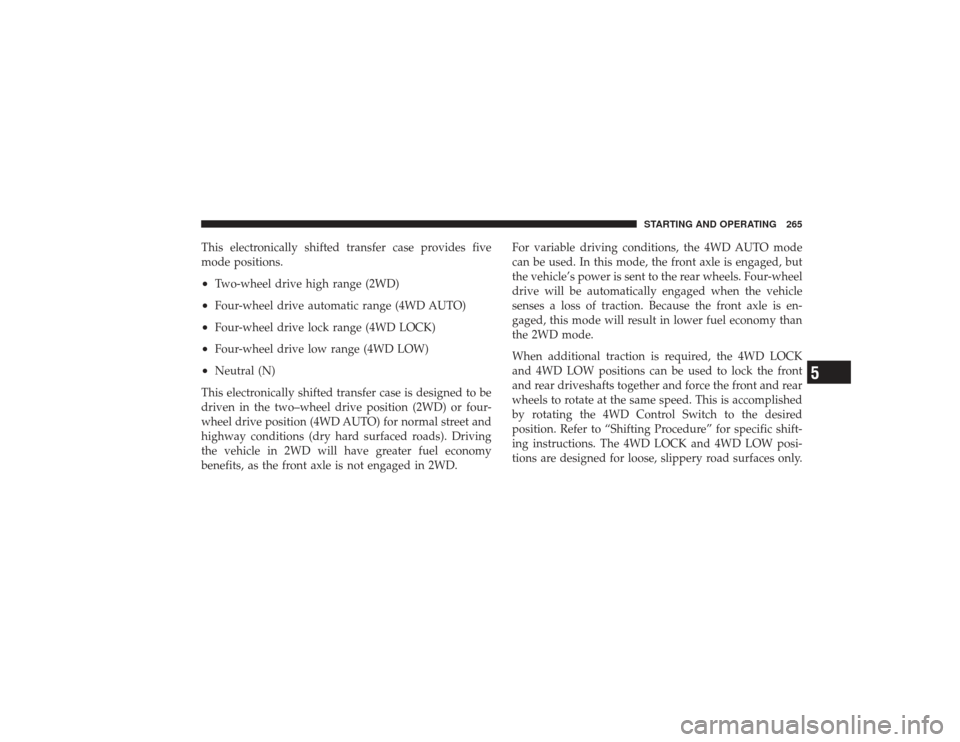
This electronically shifted transfer case provides five
mode positions.•
Two-wheel drive high range (2WD)
•
Four-wheel drive automatic range (4WD AUTO)
•
Four-wheel drive lock range (4WD LOCK)
•
Four-wheel drive low range (4WD LOW)
•
Neutral (N)
This electronically shifted transfer case is designed to be
driven in the two–wheel drive position (2WD) or four-
wheel drive position (4WD AUTO) for normal street and
highway conditions (dry hard surfaced roads). Driving
the vehicle in 2WD will have greater fuel economy
benefits, as the front axle is not engaged in 2WD. For variable driving conditions, the 4WD AUTO mode
can be used. In this mode, the front axle is engaged, but
the vehicle’s power is sent to the rear wheels. Four-wheel
drive will be automatically engaged when the vehicle
senses a loss of traction. Because the front axle is en-
gaged, this mode will result in lower fuel economy than
the 2WD mode.
When additional traction is required, the 4WD LOCK
and 4WD LOW positions can be used to lock the front
and rear driveshafts together and force the front and rear
wheels to rotate at the same speed. This is accomplished
by rotating the 4WD Control Switch to the desired
position. Refer to “Shifting Procedure” for specific shift-
ing instructions. The 4WD LOCK and 4WD LOW posi-
tions are designed for loose, slippery road surfaces only.
STARTING AND OPERATING 265
5
Page 269 of 532
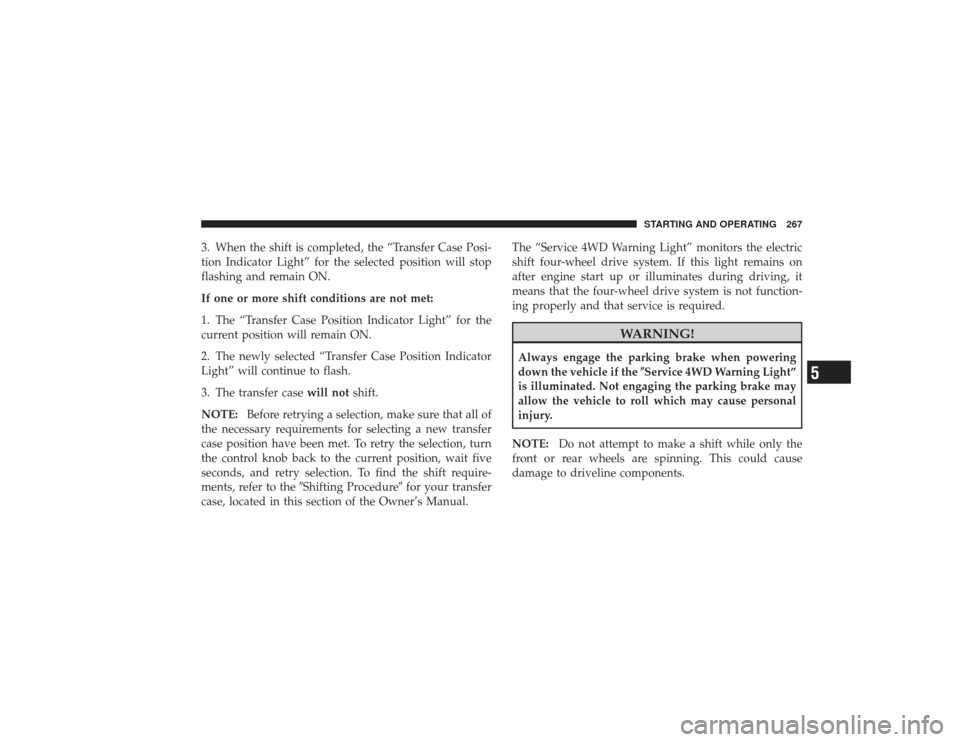
3. When the shift is completed, the “Transfer Case Posi-
tion Indicator Light” for the selected position will stop
flashing and remain ON.
If one or more shift conditions are not met:
1. The “Transfer Case Position Indicator Light” for the
current position will remain ON.
2. The newly selected “Transfer Case Position Indicator
Light” will continue to flash.
3. The transfer casewill notshift.
NOTE: Before retrying a selection, make sure that all of
the necessary requirements for selecting a new transfer
case position have been met. To retry the selection, turn
the control knob back to the current position, wait five
seconds, and retry selection. To find the shift require-
ments, refer to the �Shifting Procedure� for your transfer
case, located in this section of the Owner’s Manual. The “Service 4WD Warning Light” monitors the electric
shift four-wheel drive system. If this light remains on
after engine start up or illuminates during driving, it
means that the four-wheel drive system is not function-
ing properly and that service is required.
WARNING!
Always engage the parking brake when powering
down the vehicle if the
\bService 4WD Warning Light”
is illuminated. Not engaging the parking brake may
allow the vehicle to roll which may cause personal
injury.
NOTE: Do not attempt to make a shift while only the
front or rear wheels are spinning. This could cause
damage to driveline components.
STARTING AND OPERATING 267
5
Page 270 of 532
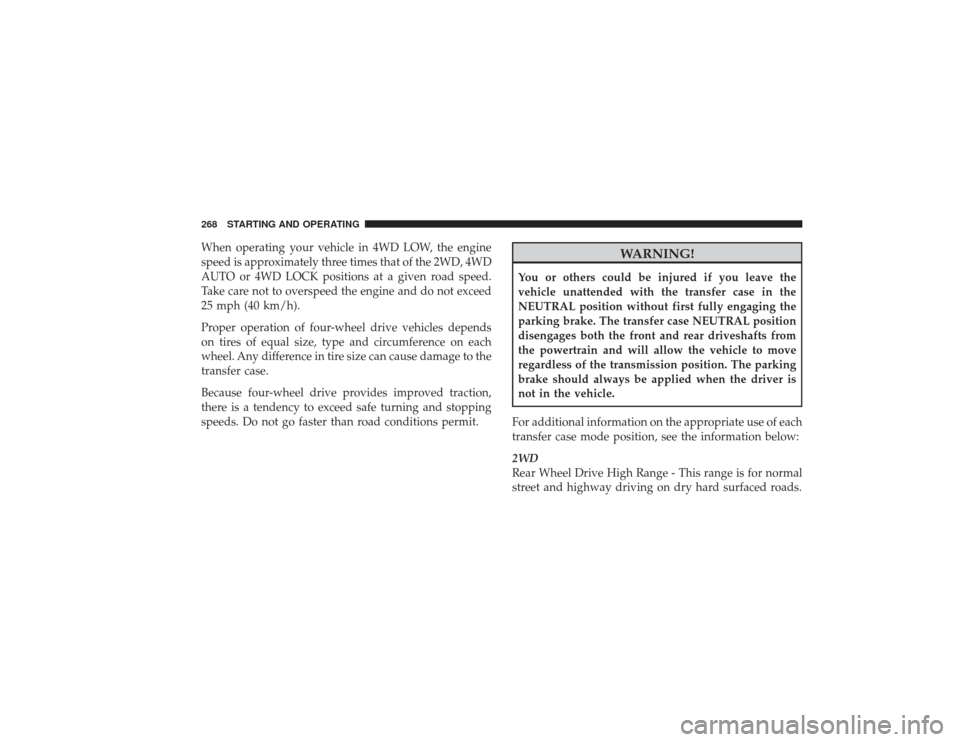
When operating your vehicle in 4WD LOW, the engine
speed is approximately three times that of the 2WD, 4WD
AUTO or 4WD LOCK positions at a given road speed.
Take care not to overspeed the engine and do not exceed
25 mph (40 km/h).
Proper operation of four-wheel drive vehicles depends
on tires of equal size, type and circumference on each
wheel. Any difference in tire size can cause damage to the
transfer case.
Because four-wheel drive provides improved traction,
there is a tendency to exceed safe turning and stopping
speeds. Do not go faster than road conditions permit.
WARNING!
You or others could be injured if you leave the
vehicle unattended with the transfer case in the
NEUTRAL position without first fully engaging the
parking brake. The transfer case NEUTRAL position
disengages both the front and rear driveshafts from
the powertrain and will allow the vehicle to move
regardless of the transmission position. The parking
brake should always be applied when the driver is
not in the vehicle.
For additional information on the appropriate use of each
transfer case mode position, see the information below:
2WD
Rear Wheel Drive High Range - This range is for normal
street and highway driving on dry hard surfaced roads.
268 STARTING AND OPERATING
Page 271 of 532
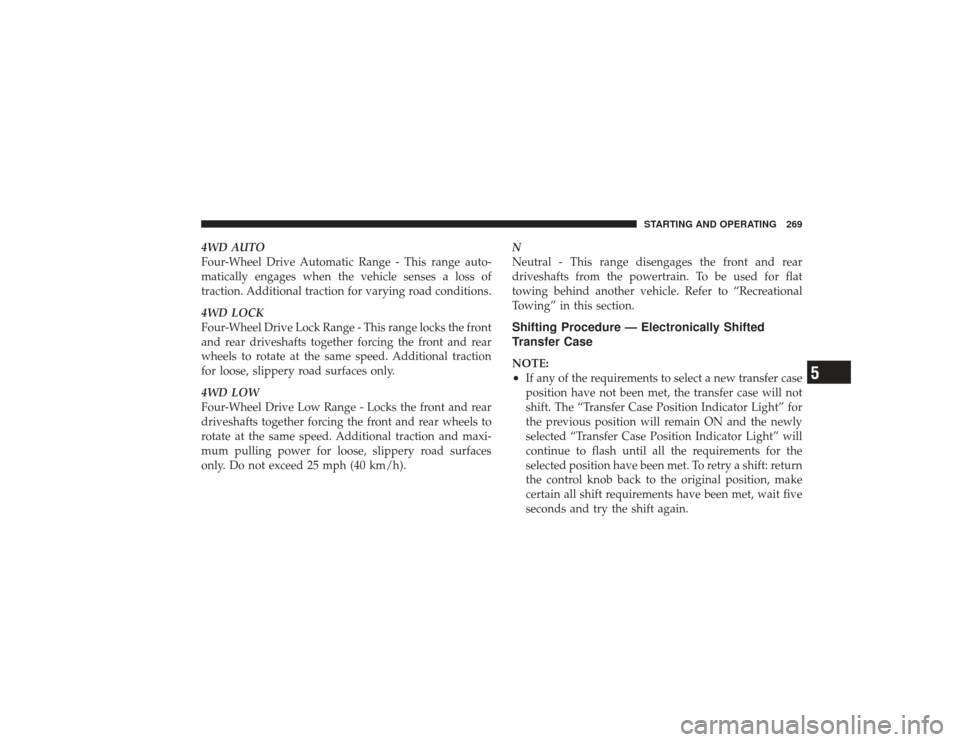
4WD AUTO
Four-Wheel Drive Automatic Range - This range auto-
matically engages when the vehicle senses a loss of
traction. Additional traction for varying road conditions.
4WD LOCK
Four-Wheel Drive Lock Range - This range locks the front
and rear driveshafts together forcing the front and rear
wheels to rotate at the same speed. Additional traction
for loose, slippery road surfaces only.
4WD LOW
Four-Wheel Drive Low Range - Locks the front and rear
driveshafts together forcing the front and rear wheels to
rotate at the same speed. Additional traction and maxi-
mum pulling power for loose, slippery road surfaces
only. Do not exceed 25 mph (40 km/h).N
Neutral - This range disengages the front and rear
driveshafts from the powertrain. To be used for flat
towing behind another vehicle. Refer to “Recreational
Towing” in this section.
Shifting Procedure — Electronically Shifted
Transfer CaseNOTE:•
If any of the requirements to select a new transfer case
position have not been met, the transfer case will not
shift. The “Transfer Case Position Indicator Light” for
the previous position will remain ON and the newly
selected “Transfer Case Position Indicator Light” will
continue to flash until all the requirements for the
selected position have been met. To retry a shift: return
the control knob back to the original position, make
certain all shift requirements have been met, wait five
seconds and try the shift again.
STARTING AND OPERATING 269
5
Page 274 of 532
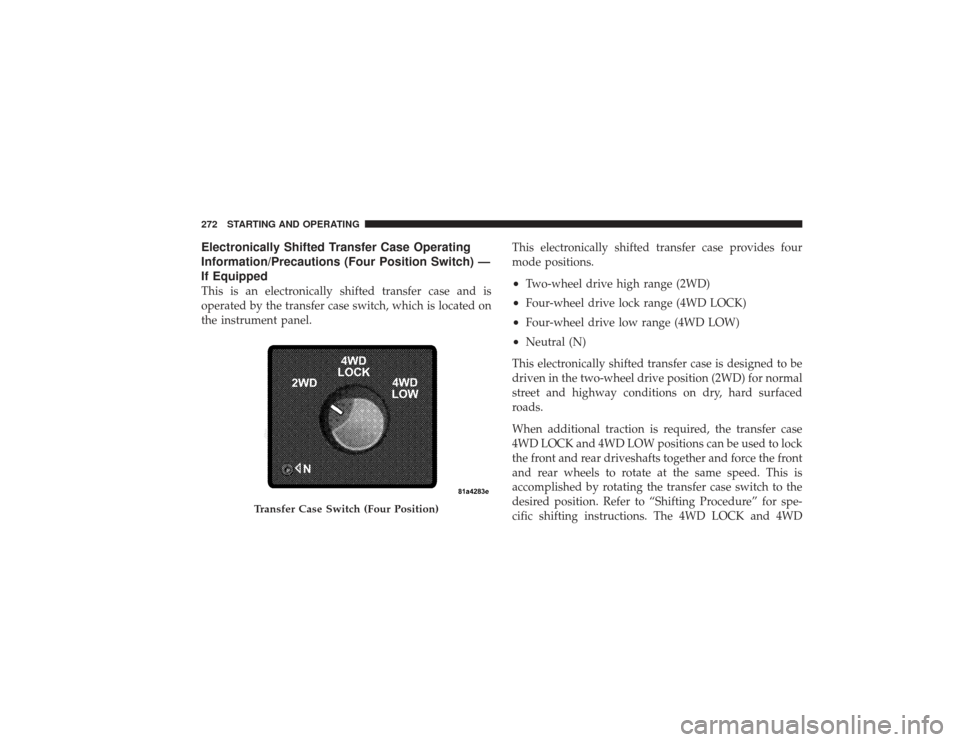
Electronically Shifted Transfer Case Operating
Information/Precautions (Four Position Switch) —
If EquippedThis is an electronically shifted transfer case and is
operated by the transfer case switch, which is located on
the instrument panel.This electronically shifted transfer case provides four
mode positions.
•
Two-wheel drive high range (2WD)
•
Four-wheel drive lock range (4WD LOCK)
•
Four-wheel drive low range (4WD LOW)
•
Neutral (N)
This electronically shifted transfer case is designed to be
driven in the two-wheel drive position (2WD) for normal
street and highway conditions on dry, hard surfaced
roads.
When additional traction is required, the transfer case
4WD LOCK and 4WD LOW positions can be used to lock
the front and rear driveshafts together and force the front
and rear wheels to rotate at the same speed. This is
accomplished by rotating the transfer case switch to the
desired position. Refer to “Shifting Procedure” for spe-
cific shifting instructions. The 4WD LOCK and 4WD
Transfer Case Switch (Four Position)
272 STARTING AND OPERATING
Page 276 of 532

2. The selected “Transfer Case Position Indicator Light”
will flash until the transfer case completes the shift.
3. When the shift is completed, the “Transfer Case Posi-
tion Indicator Light” for the selected position will stop
flashing and remain ON.
If one or more shift conditions are not met:
1. The “Transfer Case Position Indicator Light” for the
current position will remain ON.
2. The newly selected “Transfer Case Position Indicator
Light” will continue to flash.
3. The transfer casewill notshift.
NOTE: Before retrying a selection, make certain that all
the necessary requirements for selecting a new transfer
case position have been met. To retry the selection, turn
the transfer case switch back to the current position, wait five seconds, and retry selection. To find the shift require-
ments, refer to the
�Shifting Procedure� for your transfer
case, located in this section of the Owner’s Manual.
The “Service 4WD Warning Light” monitors the electric
shift four-wheel drive system. If this light remains on
after engine start up or illuminates during driving, it
means that the four-wheel drive system is not function-
ing properly and that service is required.
WARNING!
Always engage the parking brake when powering
down the vehicle if the \bService 4WD Warning Light”
is illuminated. Not engaging the parking brake may
allow the vehicle to roll, which may cause personal
injury.
274 STARTING AND OPERATING
Page 277 of 532
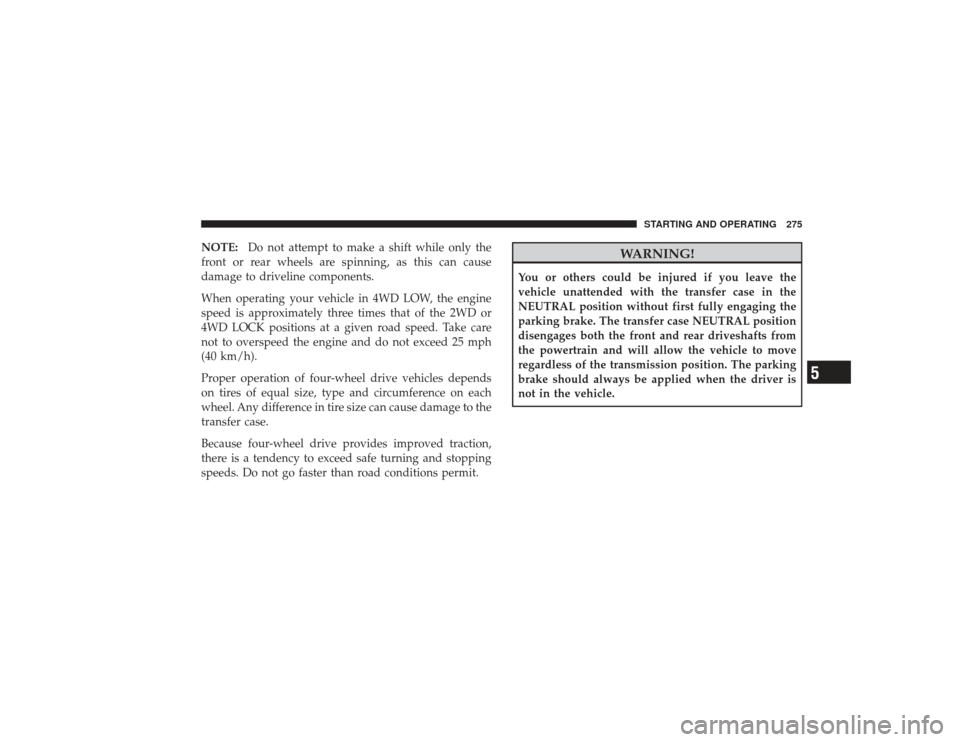
NOTE:Do not attempt to make a shift while only the
front or rear wheels are spinning, as this can cause
damage to driveline components.
When operating your vehicle in 4WD LOW, the engine
speed is approximately three times that of the 2WD or
4WD LOCK positions at a given road speed. Take care
not to overspeed the engine and do not exceed 25 mph
(40 km/h).
Proper operation of four-wheel drive vehicles depends
on tires of equal size, type and circumference on each
wheel. Any difference in tire size can cause damage to the
transfer case.
Because four-wheel drive provides improved traction,
there is a tendency to exceed safe turning and stopping
speeds. Do not go faster than road conditions permit.
WARNING!
You or others could be injured if you leave the
vehicle unattended with the transfer case in the
NEUTRAL position without first fully engaging the
parking brake. The transfer case NEUTRAL position
disengages both the front and rear driveshafts from
the powertrain and will allow the vehicle to move
regardless of the transmission position. The parking
brake should always be applied when the driver is
not in the vehicle.
STARTING AND OPERATING 275
5
Page 278 of 532
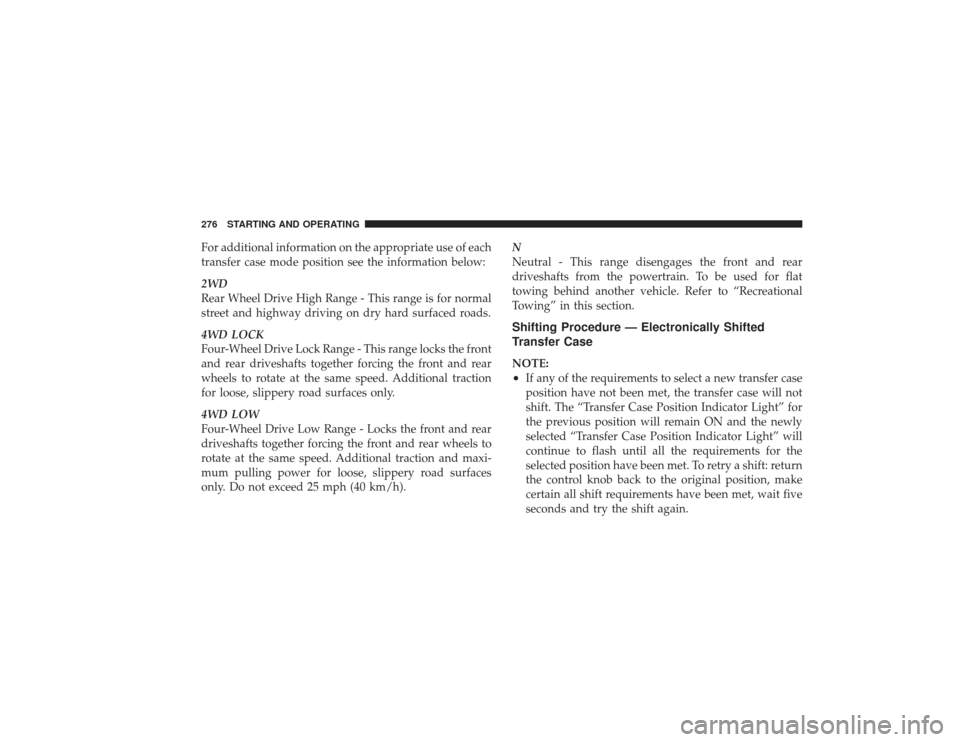
For additional information on the appropriate use of each
transfer case mode position see the information below:
2WD
Rear Wheel Drive High Range - This range is for normal
street and highway driving on dry hard surfaced roads.
4WD LOCK
Four-Wheel Drive Lock Range - This range locks the front
and rear driveshafts together forcing the front and rear
wheels to rotate at the same speed. Additional traction
for loose, slippery road surfaces only.
4WD LOW
Four-Wheel Drive Low Range - Locks the front and rear
driveshafts together forcing the front and rear wheels to
rotate at the same speed. Additional traction and maxi-
mum pulling power for loose, slippery road surfaces
only. Do not exceed 25 mph (40 km/h).N
Neutral - This range disengages the front and rear
driveshafts from the powertrain. To be used for flat
towing behind another vehicle. Refer to “Recreational
Towing” in this section.
Shifting Procedure — Electronically Shifted
Transfer CaseNOTE:•
If any of the requirements to select a new transfer case
position have not been met, the transfer case will not
shift. The “Transfer Case Position Indicator Light” for
the previous position will remain ON and the newly
selected “Transfer Case Position Indicator Light” will
continue to flash until all the requirements for the
selected position have been met. To retry a shift: return
the control knob back to the original position, make
certain all shift requirements have been met, wait five
seconds and try the shift again.
276 STARTING AND OPERATING